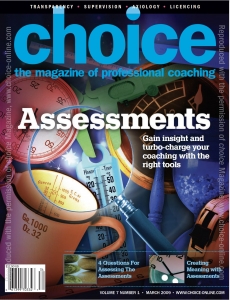
 Published in, and reproduced with permission from, choice, the magazine of professional coaching www.choice-online.com by Suzi Pomerantz and Bill Lindberg originally published in March 2009.
Published in, and reproduced with permission from, choice, the magazine of professional coaching www.choice-online.com by Suzi Pomerantz and Bill Lindberg originally published in March 2009.
After the business world reeled from the debacles of corrupt leaders who splattered the pages of the Wall Street Journal, the rebound cry was for transparency in leadership. In response to the government secrecy of the last eight years, the U.S. elected Barack Obama, who ran a campaign heralding the need for and benefits of transparent leadership. If you are coaching in business these days, you cannot avoid the latest buzzwords of transparent leadership. Authors Bennis, Goleman, and Biederman caution us that “claiming to be transparent is not the same as actually being transparent” and the containment of truth by leaders of business and government today remains a common practice (“Creating a Transparent Culture,” Leader to Leader, no.50, fall 2008). This gives coaches a tremendous and timely opportunity to coach for transparency. We must model transparency so that our leader clients can step fully into their own style and substance in a meaningful and authentic way. Authenticity is key to effective leadership, and real transparency hinges on authenticity. Transparent leadership is especially important in difficult economic times when the stakes in decision making run high. People can detect inauthentic behavior by an opaque leader who masks his authentic expression or hides information.
5 Keys of Coaching for Transparency
1. ETHICS & INTEGRITY
You cannot coach for transparency unless you are yourself a transparent leader. It ought to be a truism that ethical behavior is preferred over unethical behavior. In leadership and in coaching, we believe that “what goes around comes around.” Headlines abound, however, of those who have chosen to take a different path. If a client chooses a course that is beyond legal or ethical boundaries, there is a fear of very real legal consequences. In the coaching domain, if a coach is credentialed through the International Coach Federation (ICF), there are sanctions for unethical actions including, but not limited to, the loss of one’s credential. Even though the ICF Code of Ethics is relatively new and still evolving
when compared with professional fields with greater longevity, the precepts set forth in the ICF code provide useful guidance. We expect more comprehensive guidance and specific interpretations of the code to emerge over time. Whatever professional code of conduct is in force, however, there will always be tensions and competing interests in play. For example, as business coaches we are often hired to combine our coaching methodology with subject matter expertise or other competencies. The ICF would consider that to be consulting and therefore not aligned with
their definition of coaching. It is vitally important, therefore, that a coach has an independent set of ethics to serve as a moral compass
when interpreting a set of professional guidelines. In an increasingly fast-paced, high stakes world this is as true now has it has ever been.
Common sense guidance in the past suggested you ought not do anything that you wouldn’t want to read about on the front page of the New
York Times, which numerous business executives and public figures may wish in retrospect that they had heeded. Today it is not so much
the Times we need to worry about as the Internet and blogosphere. Transparency as a leader informs and contributes to media exposure,
online reputation and branding both internally and externally. Coaches must lead our clients towards behaviors that align with each leader’s own standards of ethics and integrity.
2. LEADERSHIP TRANSPARENCY
Coaches must have a working understanding of leadership transparency, which we define as openly sharing information, commitments,
goals, objectives, and the journey to excellence (both successes and challenges). Transparent leaders seek and include the input of those who
serve them, those who follow them, those who are peers, as well as those they follow and those they serve. Authors Warren Bennis, Daniel
Goleman and Patricia Ward Biederman in Transparency: Creating a Culture of Candor speak about “the free flow of information within an organization and between the organization and its many stakeholders, including the public. For any institution, the flow of information is
akin to the activity of a central nervous system: the organization’s effectiveness depends on it. For information to flow freely within an
institution, followers must feel free to speak openly, and leaders must welcome such openness.” In The Leadership Challenge, authors James
Kouzes and Barry Posner suggest that a paramount practice of leadership is to “model the way” by clarifying values, finding your voice,
affirming shared ideals, and setting the example by aligning actions with shared values (4th Ed. Page 26). The most prominent attributes
of credible leaders are honesty, forward-looking orientation, inspiration and competence – attributes that are consistent across cultures
and continents and congruent with what we describe as transparency. Another prominent commentator on leadership, Peter Koestenbaum,
asserts that if any aspects of the “Leadership Diamond” (courage, vision, ethics or reality) are missing, it is difficult to sustain leadership.
(Leadership: The Inner Side of Greatness, A Philosophy for Leaders, Jossey-Bass, 2002). Effective coaching requires helping a leader embody behaviors that support the achievement of these qualities. Depending on the nature of the coaching engagement and the specific contract in place, a competent coach will stimulate awareness of the potential consequences if one of these elements is missing.
3. ALIGNMENT WITH OUR CLIENT
A transparent leader will typically express a commitment to transparency. Thus, we must express our commitment to transparent coaching.
Clients who aspire to do the right thing and chart an ethical path typically seek support from a coach with a similar commitment. In fact,
leaders today value the perspective of a coach who is “outside the system.” Of course, internal coaches provide valuable coaching and perspective,
but on occasion they may be susceptible to forces within the organization or system. External coaches may, in turn, be unaware of norms or political or cultural forces within an organization. Because of these dynamics, it becomes all the more important for transparency and candor in the relationship between coach, client and sponsor.
4. ARTICULATING PURPOSE AND RATIONALE
Transparent coaching can be defined as openly expressing the purpose and rationale behind a particular coaching thread of questions, or a
particular set of coaching practices. Whatever issues prompt a leader to seek out a coach, trust is a critical ingredient in the relationship. Trust
is in no way an automatic element of a coaching relationship; it must be earned and it tends to deepen over time unless a coach does something to
dispel or break that trust (such as violating confidentiality). The culture and context of a coaching relationship can also determine the tenor and success of a coaching engagement. If multi-rater assessment tools (360’s) have a history in an organization of being used to pummel employees at performance review times, for instance, a client may not be receptive to participating in such a process without credible reassurance. The coach needs to be attentive to the cultural context to assess whether or not there are risks attendant to particular approaches that may be beyond the coach’s control.In our experience, a transparent coaching relationship founded on candor and openness heightens the impact of the results.
5. REMEMBERING WHOSE AGENDA PREVAILS
Modeling transparency for our clients does not mean driving an agenda of making them into transparent leaders if that is not their own commitment or intention. Even though this article is a paean of transparent, straightforward, ethical coaching, we assert that the client’s agenda ought to be paramount. Our obligation as coaches is to “discover, clarify and align with what the client wants to achieve.” (ICF Philosophy of Coaching). In the final analysis, our own transparent leadership around our contracting, discovery, intuition, clarity, alignment with our clients, and our reliance upon what we observe can help us to help our clients maintain and enhance their transparency and efficacy as leaders.
Published in, and reproduced with permission from, choice, the magazine of professional coaching www.choice-online.com by Suzi Pomerantz and Bill Lindberg originally published in March 2009. Download available below.
Download Article 1K Club

















